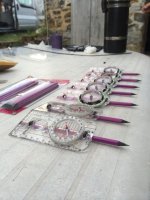Pitlamp
Well-known member
Just had a look around the Cave Registry Data Archive - good effort all concerned. I think a lot of the data from Keld Head originates from me and from Rupert Skorupka. It starts with this comment which someone has added:
;Water level at Keld Head resurgence is 252.36m altitude.
;KMC dive line belay is 1.2m above water level in diving data, but dry survey in KMC puts this at 267.37m (13.8m too high!).
;Adding vertical adjustment to link between diving data and dry data makes things worse as the
;bug in loop corrections with diving data in Survex actually pulls the depth of the deepest part
;of the sump down by over 20m as it is. Adding an adjustment for the upstream end just makes this worse.
Having surveyed all the way from KH to KMC I can reassure folk that the water level is the same at both ends! (One of the massive advantages of a diving survey over a dry cave survey is the levelling precision it offers.) As the originator of these data, if there's anything I can do to help sort out this anomaly, please PM me. However, it seems the problem must lie within the overland data, not the underwater data. Trying to sort this by altering the depths recorded in the underwater cave is not the solution; these were very carefully recorded with a precision instrument reading to +/- 10 cm.
Mods - this doesn't really belong here (sorry Badlad; wasn't trying to hijack your excellent topic). Probably better transferred to a new topic altogether?
;Water level at Keld Head resurgence is 252.36m altitude.
;KMC dive line belay is 1.2m above water level in diving data, but dry survey in KMC puts this at 267.37m (13.8m too high!).
;Adding vertical adjustment to link between diving data and dry data makes things worse as the
;bug in loop corrections with diving data in Survex actually pulls the depth of the deepest part
;of the sump down by over 20m as it is. Adding an adjustment for the upstream end just makes this worse.
Having surveyed all the way from KH to KMC I can reassure folk that the water level is the same at both ends! (One of the massive advantages of a diving survey over a dry cave survey is the levelling precision it offers.) As the originator of these data, if there's anything I can do to help sort out this anomaly, please PM me. However, it seems the problem must lie within the overland data, not the underwater data. Trying to sort this by altering the depths recorded in the underwater cave is not the solution; these were very carefully recorded with a precision instrument reading to +/- 10 cm.
Mods - this doesn't really belong here (sorry Badlad; wasn't trying to hijack your excellent topic). Probably better transferred to a new topic altogether?




